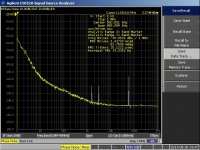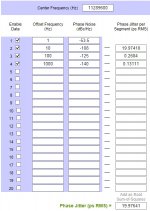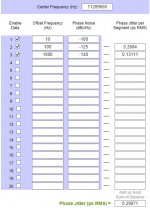Hi guys, I'm on holiday at the moment (skiing in Park City, UT), so my replies will be few and far between.
Personally, I don't find soldering PCBs of this scale too hard. That said, you'd want to use a proper soldering station, a fairly fine tip and a finer diameter solder. I use a Hakko 936 with a 1.2mm chisel tip and Multicore 0.71mm 60/40 solder. With this sort of equipment and the correct technique you'll have no issues with a fine scale PCBs like this clock.
I realise sourcing the components can be tricky in low quantities, which is why I offered kits for the groupbuy (there wasn't much uptake, most people only got PCBs). I might start offering the kits all the time like I currently do with the PCBs, but please realise that it's quite time consuming, and I sell them at cost. If you really run into trouble, do contact me. I may be able to sell you some parts (once I'm back from holiday).
@j baldam: I'm glad your clock is working. The position you picked looks okay, but I'd be careful about using self adhesive standoffs. They're not very secure, it wouldn't take too much of a shock to peel them off. They also tend to lose their grip over time. I'd also think about adding some glue as strain relief where the wires attach to the main PCB (a bit like Marantz has done on many of the connectors). I also wouldn't have socketed the comparator.
The upgraded regulator is a good idea. There's a couple more things I would consider doing:
- Adding damping. There are threads arround on this topic.
- Upgrading the S/P DIF output circuit. Often they're just built as an afterthought to add value to the player, and can really be improved. Designing a transmission line driver isn't a trivial task though.
Personally, I don't find soldering PCBs of this scale too hard. That said, you'd want to use a proper soldering station, a fairly fine tip and a finer diameter solder. I use a Hakko 936 with a 1.2mm chisel tip and Multicore 0.71mm 60/40 solder. With this sort of equipment and the correct technique you'll have no issues with a fine scale PCBs like this clock.
I realise sourcing the components can be tricky in low quantities, which is why I offered kits for the groupbuy (there wasn't much uptake, most people only got PCBs). I might start offering the kits all the time like I currently do with the PCBs, but please realise that it's quite time consuming, and I sell them at cost. If you really run into trouble, do contact me. I may be able to sell you some parts (once I'm back from holiday).
@j baldam: I'm glad your clock is working. The position you picked looks okay, but I'd be careful about using self adhesive standoffs. They're not very secure, it wouldn't take too much of a shock to peel them off. They also tend to lose their grip over time. I'd also think about adding some glue as strain relief where the wires attach to the main PCB (a bit like Marantz has done on many of the connectors). I also wouldn't have socketed the comparator.
The upgraded regulator is a good idea. There's a couple more things I would consider doing:
- Adding damping. There are threads arround on this topic.
- Upgrading the S/P DIF output circuit. Often they're just built as an afterthought to add value to the player, and can really be improved. Designing a transmission line driver isn't a trivial task though.
Hi Anton, happy holidays.
I soldered mine with a 30watt iron with quite a large pointy tip, but I managed.
I socket-ed the IC because I didn't want to risk frying it, does it matter much?
I've had a short listen since and initially I've found that the player may be better as a player than a transport now, given that my Dac is chinese modded as per
http://www.diyaudio.com/forums/digital-source/186245-dac-2496-ak4393-dac-kit-cs8416-ak4393-5532-a.html
This needs more investigation so I'll be doing more comparisons with and without the DAC.
I soldered mine with a 30watt iron with quite a large pointy tip, but I managed.
I socket-ed the IC because I didn't want to risk frying it, does it matter much?
I've had a short listen since and initially I've found that the player may be better as a player than a transport now, given that my Dac is chinese modded as per
http://www.diyaudio.com/forums/digital-source/186245-dac-2496-ak4393-dac-kit-cs8416-ak4393-5532-a.html
This needs more investigation so I'll be doing more comparisons with and without the DAC.
Hi, thought I'd post a couple of findings re the clock.
It's performing faultlessly and giving me a lot more ambiance to the sound.
Quieter sounds that cut off previously now go on for longer and music flows better.
It now sounds better for me as a transport and as a bonus my hybrid SACD gold version of Dark side now plays where it would not play on my 6000KI previously.
It's performing faultlessly and giving me a lot more ambiance to the sound.
Quieter sounds that cut off previously now go on for longer and music flows better.
It now sounds better for me as a transport and as a bonus my hybrid SACD gold version of Dark side now plays where it would not play on my 6000KI previously.
Hi Anton,
I want to connect your DLJ clock to replace the 16.93mhz Citizen oscillator which connects to the Xin and Xout of the IC LC78601E from my Shigaclone. Should I connect the low Jitter clock J101.1 to Xin and J101.2 to a Ground point nearby or pin 50 ? The Tent lab part is optional.
Thanks
I want to connect your DLJ clock to replace the 16.93mhz Citizen oscillator which connects to the Xin and Xout of the IC LC78601E from my Shigaclone. Should I connect the low Jitter clock J101.1 to Xin and J101.2 to a Ground point nearby or pin 50 ? The Tent lab part is optional.
Thanks
An externally hosted image should be here but it was not working when we last tested it.
Thanks for the measurements Andrea, they're really interesting to see, and I have no hope of making them myself. I'm pretty happy, -108dBc/Hz @ 10Hz is a solid number, though the noise floor of -147dBc/Hz could be better. What do you think the three spurs are, reflections?
Thanks for the measurements Andrea, they're really interesting to see, and I have no hope of making them myself. I'm pretty happy, -108dBc/Hz @ 10Hz is a solid number, though the noise floor of -147dBc/Hz could be better. What do you think the three spurs are, reflections?
The measurement has been done in a university lab. It did take 5 minutes only to do the measurement, I believe in an hour or so the phase noise performance should be better, also the noise floor.
BTW, it's not a bad phase noise plot, it's at least 6dB better than the Crystek or Tentlabs XO.
About the spurs, I don't know. I measured the DC version powered by a LiFePo battery followed by an LC filter.
About the jitter, it depends on how many segments have been integrated. The measurement have been done very close to the carrier (1Hz), so the first segment is dominant. Tipically the manufacturers start the measurement at 10Hz from the carrier, so the RMS phase jitter seems much better.
Attached a simple phase noise to jitter conversion of this oscillator starting from 1 and 10Hz. As you can see the results are a bit different: around 20 ps starting from 1Hz, but less than 0.3 ps starting from 10Hz.
Andrea
Attachments
@andrea_mori: Yeah, that makes sense. The 20ps number threw me off at first, 0.2ps seems a much more compatible number to other oscillators, I think 10Hz is the normal starting point. That's why I always prefer to look at a phase noise plot, jitter numbers can be easily distorted.
There's been a bit of interest in kits again. I will be ordering parts, so kits will be available again. PCBs are always available. DC kits are USD30, AC kits are USD40, bare PCBs are USD3 (kits include a bare PCB), same as the second round of the groupbuy.
There's been a bit of interest in kits again. I will be ordering parts, so kits will be available again. PCBs are always available. DC kits are USD30, AC kits are USD40, bare PCBs are USD3 (kits include a bare PCB), same as the second round of the groupbuy.
Last edited:
I've prepared an order for parts for the kits, it's been a while since the last group buy round so there have been a few changes to the bill of materials. Notably:
- Some kits will get LM431s instead of TL431s, they're both the same thing.
- Block VB1.5/2/6 transformers instead of the Myrra 44091. They're equivalent, I'd have rather used the Myrra as they're cheaper, but my normal supplier is out of stock. A reminder that these are 220 to 240VAC transformers, if you're from a 100 to 120VAC country, please stick to the DC kits.
The other thing is crystals. Last time I shipped three crystals (11.2896, 16.9344 and 33.8688MHz) with each kit, I think this time I'll ship up to two of your choice from the following list:
- 11.2896MHz Citizen HC49US
- 12.288MHz Citizen HC49US
- 16.9344MHz TXC HC49S
- 24.576MHz TXC HC49S
- 33.8688MHz Generic
I'll only have so many of each though, I may run out of a particular value.
Attached is an up to date schematic and bill of materials.
- Some kits will get LM431s instead of TL431s, they're both the same thing.
- Block VB1.5/2/6 transformers instead of the Myrra 44091. They're equivalent, I'd have rather used the Myrra as they're cheaper, but my normal supplier is out of stock. A reminder that these are 220 to 240VAC transformers, if you're from a 100 to 120VAC country, please stick to the DC kits.
The other thing is crystals. Last time I shipped three crystals (11.2896, 16.9344 and 33.8688MHz) with each kit, I think this time I'll ship up to two of your choice from the following list:
- 11.2896MHz Citizen HC49US
- 12.288MHz Citizen HC49US
- 16.9344MHz TXC HC49S
- 24.576MHz TXC HC49S
- 33.8688MHz Generic
I'll only have so many of each though, I may run out of a particular value.
Attached is an up to date schematic and bill of materials.
Attachments
do you have 25Mhz version.
thanks
thanks
I've prepared an order for parts for the kits, it's been a while since the last group buy round so there have been a few changes to the bill of materials. Notably:
- Some kits will get LM431s instead of TL431s, they're both the same thing.
- Block VB1.5/2/6 transformers instead of the Myrra 44091. They're equivalent, I'd have rather used the Myrra as they're cheaper, but my normal supplier is out of stock. A reminder that these are 220 to 240VAC transformers, if you're from a 100 to 120VAC country, please stick to the DC kits.
The other thing is crystals. Last time I shipped three crystals (11.2896, 16.9344 and 33.8688MHz) with each kit, I think this time I'll ship up to two of your choice from the following list:
- 11.2896MHz Citizen HC49US
- 12.288MHz Citizen HC49US
- 16.9344MHz TXC HC49S
- 24.576MHz TXC HC49S
- 33.8688MHz Generic
I'll only have so many of each though, I may run out of a particular value.
Attached is an up to date schematic and bill of materials.
- Status
- This old topic is closed. If you want to reopen this topic, contact a moderator using the "Report Post" button.
- Home
- Group Buys
- Discrete Low Jitter Clock GB


